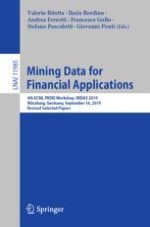2020 | Buch
Mining Data for Financial Applications
4th ECML PKDD Workshop, MIDAS 2019, Würzburg, Germany, September 16, 2019, Revised Selected Papers
herausgegeben von: Valerio Bitetta, Dr. Ilaria Bordino, Prof. Andrea Ferretti, Francesco Gullo, Stefano Pascolutti, Giovanni Ponti
Verlag: Springer International Publishing
Buchreihe : Lecture Notes in Computer Science
